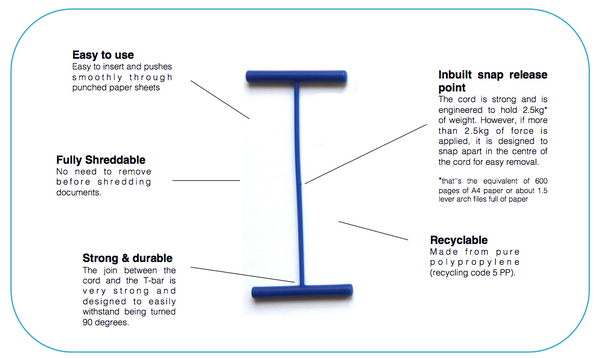About
A Bit of History
Metal and plastic-ended treasury tags
Treasury tag paper fasteners have been around for over 100 years. Winston Churchill used them to hold his speeches together. They are sold in most stationery shops in the UK and online.
The traditional treasury tag is made with a green cotton string with two metal 'T-bar' ends. Subsequent versions have been produced with plastic ends (instead of metal) or with elastic in the middle.
Who uses treasury tags?
Treasury tags have been, at least historically, routinely used in UK government departments and by 'paper heavy' professions (such as solicitors and accountants). They are great for holding together larger volumes of paper (such as long reports or printed chapters of a book), particularly if you are on the move and don't want to lug around a bulky lever arch file. They are also handy for fastening household bills (where you can keep adding new bills to the tag as they arrive). Treasury tags are used to bind exam answer sheets together in most UK schools and universities (and some university courses require essays and dissertations to be bound with treasury tags).
Why are they called treasury tags?
The name is believed to derive from HM Treasury (the UK government's economic and finance ministry). They were also previously known as India tags (after the India Office, which was the British government department created to oversee the provinces of British India).
What is wrong with traditional treasury tags?
Whilst classic cotton and metal-ended treasury tags are great, they have their limitations (this also applies to plastic-ended and elastic treasury tags):
-
Limit on paper width: Because classic treasury tags are threaded through hole punched holes using the length of the T-bar, and most T-bars are 25mm in length, there is a limit to the amount of paper you can feed them through (i.e. no more than 25mm thick). Whilst you can poke them through thicker volumes of paper using a pencil or other implement, or feed them through incrementally section by section, it can be tricky and time-consuming and difficult to then take them off again.
-
Clogging and unthreading: If you use treasury tags and then want to remove them, you have to cut them off or unthread them back through the hole punched hole.
- Shredding and recycling: Because of their metal ends, classic treasury tags can't be put through shredders (and can't be easily recycled unless taken apart).
Whilst the classic treasury tag has a long and rich history, and a loyal fan base, it has its functional limitations.
T-Tag® Treasury Tags
What is the T-Tag treasury tag?
Designed in the UK and launched in 2015, the T-Tag treasury tag is a modern, colourful version of the classic treasury tag. It is designed to look better and work better and is patent pending.
What makes T-Tag treasury tags better?

T-Tag fasteners have the following advantages over traditional treasury tags:
-
Easier to insert: Because of their semi-rigid polypropylene plastic cord, T-Tag treasury tags push smoothly through hole punched paper using the length of the cord (unlike classic treasury tags which can only be threaded through using the length of the T-bar at the end). This means that T-Tag treasury tags do not have to be pushed through incrementally and can hold paper as thick as the length of the cord, less half of the length of the T-bar (for example, for the 50mm version which has a 25mm T-bar, it can hold paper up to 37.5 mm thick). This means both the T-bar and the cord do not need to be as long.
-
Shreddable and recyclable: T-Tag treasury tags are fully shreddable, so there is no need to waste time going through piles of papers to remove them. They are also fully recyclable.
- Inbuilt break point: The cord of a T-Tag treasury tag is strong and durable but is designed with a deliberate break point in the centre of the cord for easy removal if more than 2.5kg of force is applied. That is about the weight of 600 A4 pages or 1.5 to 2 lever arch files full of A4 paper. It is therefore more than strong enough to hold large quantities of paper but can be snapped off if given a sharp tug.
Check out the video below.
Who manufactures T-Tag treasury tags?
T-Tag treasury tags are exclusively produced by T-Tag Technologies. They are made in multiple colours and sizes and can be purchased here.
